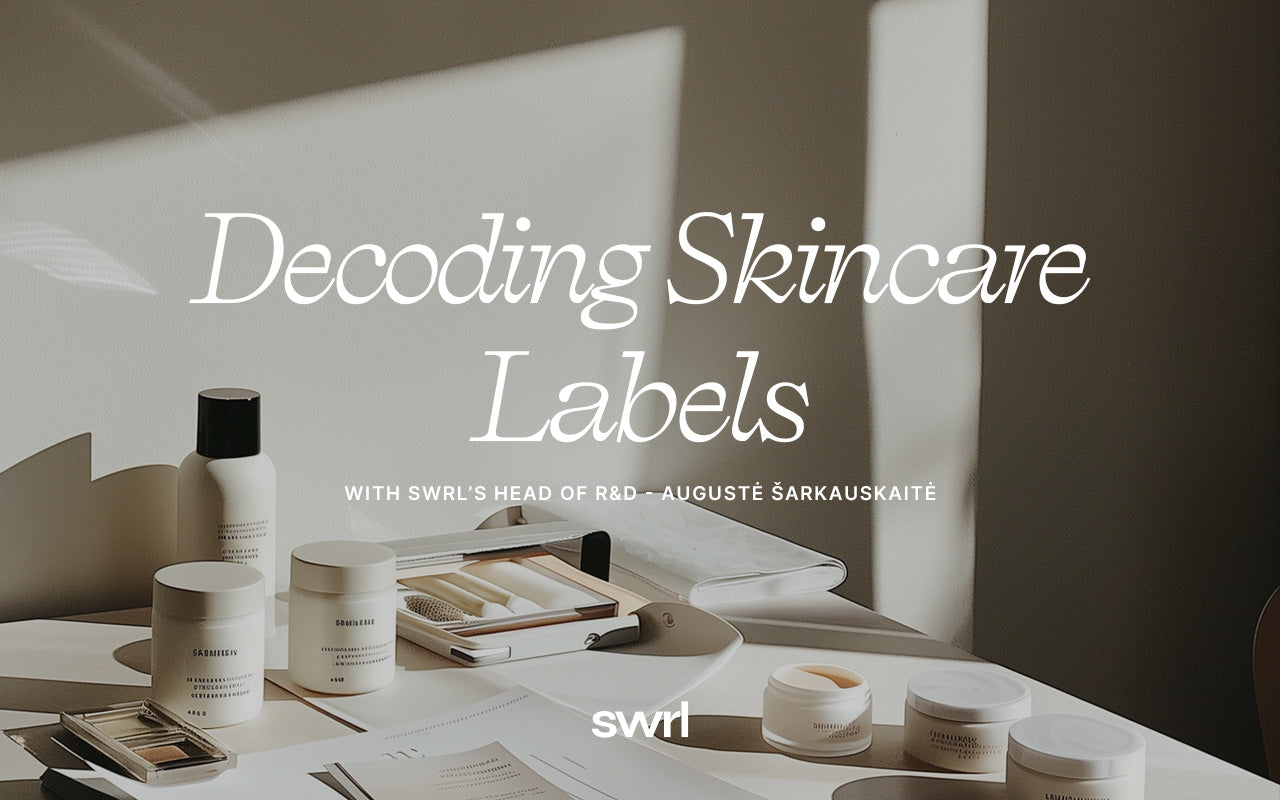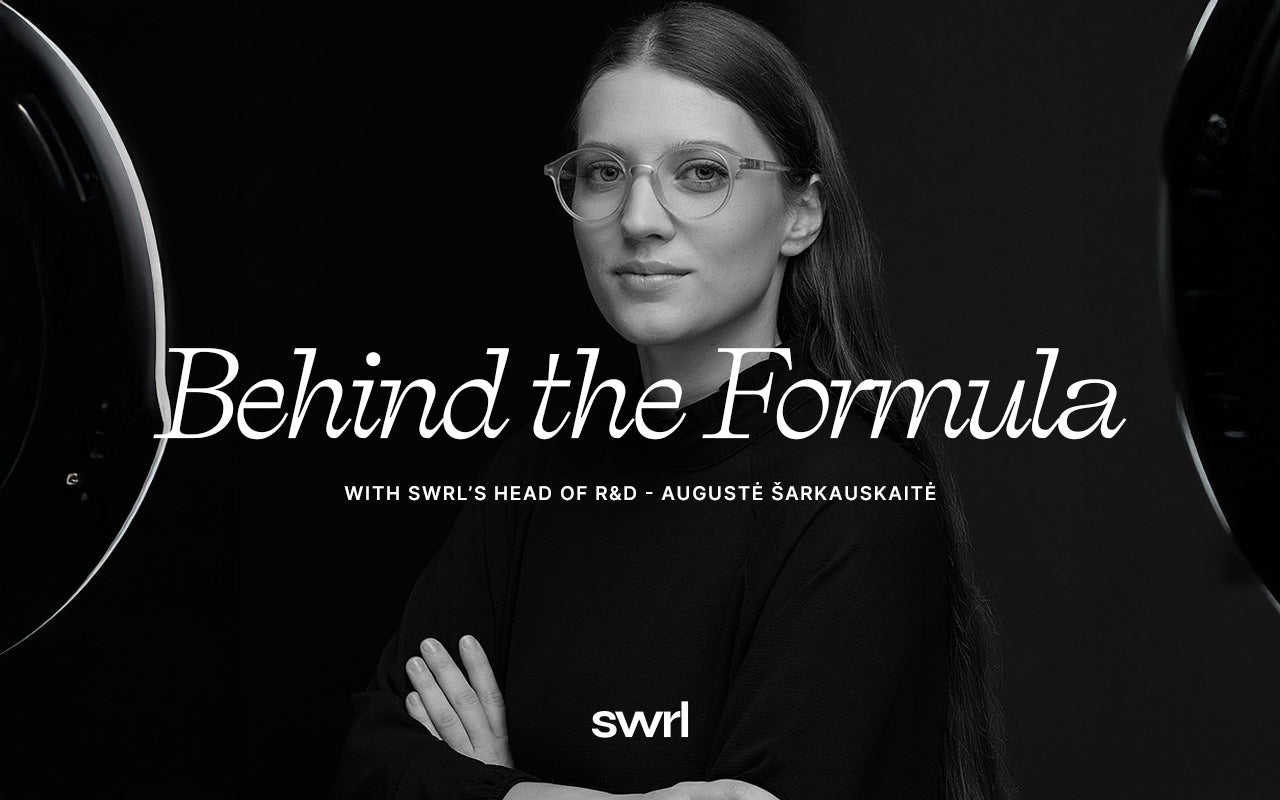Kosmetikos chemiko požiūris į tai, kodėl ingredientų sąrašų dekodavimas gali būti klaidinantis
Kaip SWRL tyrimų ir plėtros vadovė, per savo karjerą išanalizavau tūkstančius ingredientų sąrašų. Pastebėjau, kaip kitaip juos vertinu dabar, palyginti su savo pirmosiomis dienomis kosmetikos chemijos srityje. Ši evoliucija suformavo mūsų požiūrį į formulių skaidrumą SWRL – sąžiningumą dėl to, kas svarbu, o kas ne, kai kalbama apie jūsų odos priežiūrą.
INCI analizės iššūkis
Kartais manęs prašoma išanalizuoti produkto INCI sąrašą ir nuspręsti, ar jis „geras“, ar „blogas“, ar verta jį pirkti. Apmąsčiusi, kaip dabar sprendžiu šią užduotį, palyginti su tuo, kaip ją dariau savo karjeros pradžioje kaip kosmetikos formulių kūrėja, suprantu, kad mano požiūris pasikeitė ir dabar į šią užduotį žiūriu visai kitaip. Taigi, panagrinėkime INCI sąrašo „analizės“ privalumus ir trūkumus.
Kaip profesionalūs kosmetikos formulių kūrėjai, turime žinių ir įrankių, leidžiančių suprasti ne tik atskiras INCI sąrašo medžiagas, bet ir suprasti bei rasti galimą sąveiką ir sinergiją tarp atskirų ingredientų. Daugeliu atvejų chemikai gali identifikuoti mišinius, aktyvius ar funkcinius komponentus ir stabilizavimo procesus, taip pat išskaidyti produktą, kad jo ingredientai būtų klasifikuojami į kategorijas, kurios sudaro visavertę kosmetikos formulę. Taigi galiausiai formulių kūrėjas gali atkartoti produktą ir sukurti „dublikatą“ (nekalbėsiu apie jo etiką) tiesiog turėdamas INCI sąrašą ir idealiu atveju etaloninį produktą.
Ko galite sužinoti iš INCI sąrašo
Tačiau ar tikslu išskaidyti INCI sąrašą į atskirus ingredientus, siekiant įvertinti produkto veiksmingumą ir kokybę vartotojo požiūriu? Tam tikra prasme taip. Iš jo galima gauti daug informacijos. Pavyzdžiui:
- Produkte esančios sudedamosios dalys: Visas produkte esančias sudedamąsias dalis galite matyti mažėjančia tvarka iki 1 % žymos (o vėliau – bet kokia tvarka). Arba galite patikrinti, ar visi produkto teiginiuose reklamuojami komponentai yra produkte ir ar jų kiekis atitinka prasmę.
- Jautrumas arba alergijos: galite nustatyti ingredientus, į kuriuos galite būti linkę reaguoti.
- Asmeniniai pageidavimai: Galite vengti tam tikrų ingredientų dėl tvarumo problemų, jų cheminės sudėties, gyvenimo būdo, kultūrinių ar religinių pageidavimų.
- Pageidaujami ingredientai: galite pastebėti naudingus ingredientus, kurie atitinka jūsų odos tipą, problemas ar pageidavimus. Arba galite atpažinti populiarius ingredientus socialiniuose tinkluose (nors ar jie verti jūsų laiko ar pinigų, yra visai kitas klausimas).
Etikečių skaitymo apribojimai
Nepaisant to, vertinant produktą vien pagal jo INCI sąrašą, dažnai pernelyg supaprastinami jo galimi privalumai ar trūkumai.
Kosmetikos gaminiai gaminami iš ingredientų, kurie suteikia produktui formą ir jį stabilizuoja. Konservantai užtikrina saugumą ilgalaikiam naudojimui, veikliosios medžiagos – veiksmingumą, o kiti komponentai prisideda prie juslinių savybių, tokių kaip tekstūra, tepamumas ir kvapas. Tai pernelyg supaprastintas požiūris, nes ne visi šie ingredientų tipai yra kiekviename produkte, tačiau tai iliustruoja formulės sudėtingumą.
Pamenu, kaip dirbau su ankstyvu SWRL prototipu, kuris ant popieriaus atrodė „švaresnis“ ir turėjo mažiau ingredientų. Formulė atrodė prabangiai ir pradiniuose bandymuose veikė gerai, tačiau per tris mėnesius jos veiksmingumas gerokai sumažėjo. Tai mane išmokė svarbios pamokos – kartais papildomi stabilizatoriai ir funkciniai ingredientai, nors ir ilgina INCI sąrašą, yra būtini norint gauti nuoseklius rezultatus laikui bėgant.
Paslėpta „chemiškai atrodančių“ ingredientų paskirtis
Kai kurie INCI išvardyti ingredientai galėjo būti sąmoningai neįtraukti į formulę kaip atskiri komponentai. Vietoj to, jie gali būti naudojami siekiant stabilizuoti arba sustiprinti kitų ingredientų, tokių kaip antioksidantai, konservantai ar stabilizatoriai, kurie apsaugo veikliąsias ar struktūrines žaliavas, arba įsiskverbimo stiprikliai, kurie padidina ingredientų veiksmingumą, veiksmingumą. Galutinėje formulėje jų gali būti tik kaip pėdsakai, tačiau jie vis tiek turi būti įtraukti į INCI.
Pavyzdžiui, mūsų drėkinamasis esencija. Jei pažvelgtumėte tik į INCI sąrašą, jums gali kilti klausimas, kodėl įtraukėme fenoksietanolį. Tačiau iš karto nepastebima, kad ši konservantų sistema yra kruopščiai sukalibruota taip, kad apsaugotų mūsų Toskanos sraigių gleives nepakenkiant jų veiksmingumui – tai aš tris mėnesius tobulinau savo laboratorijoje.
Pavyzdžiui, jei formulėje naudojama daug skirtingų aktyviųjų ar struktūrinių ingredientų, gali atrodyti, kad jūsų produkte yra daug „chemijos“. Tai juokingas terminas, nes visi ingredientai – natūralūs ar sintetiniai – yra sudaryti iš cheminių junginių. Be to, kaip minėjau anksčiau, kosmetikos gaminys nėra tiesiog veikliųjų junginių mišinys; jis turi būti vientisas, stabilus ir, svarbiausia, saugus visą galiojimo laiką. Norint tai pasiekti, dažnai reikia pridėti struktūrinių ingredientų, dėl kurių INCI sąrašas gali atrodyti sudėtingesnis, nei yra iš tikrųjų, o kartais kliento akyse jis gali atrodyti labai sudėtingas ir nereikalingas.
Žvilgsnis už sąrašo ribų
Ir, mano nuomone, dėl tiek daug prieštaringos informacijos internete, kartais praleidžiame galimybę naudoti saugius ir veiksmingus produktus, nes sutelkiame dėmesį į vieną detalę didesnėje cheminėje dėlionėje.
SWRL mes kitaip žiūrime į ingredientų skaidrumą. Užuot reklamavę teiginius „be priedų“ ar pernelyg supaprastintas „aiškias“ etiketes, mes sutelkiame dėmesį į tai, kodėl kiekvienas ingredientas atlieka savo funkciją mūsų formulėse. Tikime, kad jūs nusipelnėte suprasti ne tik tai, kas yra jūsų produktų sudėtyje, bet ir kaip jie kartu veikia, kad duotų rezultatų.
Taigi, mano patarimas – ieškoti produktų, kurie tinka jūsų odos tipui, teikti pirmenybę moksliškai patikrintiems aktyviems ingredientams ir užtikrinti, kad produktas turėtų veiksmingą konservavimo ir stabilizavimo sistemą, užtikrinančią saugumą. Visada atminkite, kad produkto veiksmingumą lemia visa formulė, o ne tik atskiri ingredientai. Ir galiausiai INCI sąrašas negali pasakyti, ar šis produktas tiks jūsų odai, ar ne – turite jį išbandyti (saugiai – visada pirmiausia atlikite testą ant nedidelio odos kiekio).
Mielai išgirsčiau jūsų klausimus apie konkrečius ingredientus ar formulavimo būdus. Rašykite juos komentaruose, o dažniausiai užduodamus atsakysiu kitame savo dienoraščio įraše.
P. S. Galbūt būtų gera mintis turėti kosmetikos vaistininką kaip draugą. 😊


Palikti komentarą
Ši svetainė apsaugota „hCaptcha“, taip pat taikoma „hCaptcha“ privatumo politika ir paslaugos teikimo sąlygos.